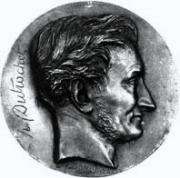Henri Dutrochet
| Henri Dutrochet | |
|---|---|
 Henri Dutrochet | |
| Born |
November 14, 1776 Poitou |
| Died |
February 4, 1847 (aged 70) Paris |
| Nationality | France |
| Fields |
Physician Botanist Physiologist |
| Author abbrev. (botany) | Hola |
René Joachim Henri Dutrochet (November 14, 1776 – February 4, 1847) was a French physician, botanist and physiologist. He is best known for his investigation into osmosis.
Early career
Dutrochet was born in Néons to a noble family, soon ruined in the French Revolution. In 1799 he entered the military marine at Rochefort, but soon left it to join the Vendean army. He then left it to tend to his family's manor in Touraine. There, he was a keen addition to the scientific nation.
Contributions
His scientific publications were numerous, and covered a wide field, but his most noteworthy work was embryological. His Recherches sur l'accroissement et la reproduction des végétaux, published in the Mémoires du museum d'histoire naturelle for 1821, procured him in that year the French Academys prize for experimental physiology. In 1837 appeared his Mémoires pour servir a l'histoire anatomique et physiologique des végétaux et des animaux, a collection of all his more important biological papers.
He investigated and described osmosis,[1] respiration, embryology, and the effect of light on plants. He has been given credit for discovering cell biology and cells in plants and the actual discovery of the process of osmosis. His early researches into the voice introduced the first modern concept of vocal cord movement.
The Mauritian plant genus Trochetia was named in his honour.
Works
- New Theory of the Voice (1800)
- New Theory of Harmony (1810)
- Researches in the growth and reproduction of plants (1821)
- Research in Osteogenesis (bone production) (1822)
- Research in the anatomy of animals and plants (1824)
- Research in an agent's immediate vital movement (1826)
- Research in Endosmosis and Exosmosis (1828)
- Research in the development of the egg and the fetus
- Research in Radial development in plants and the ascent of Sap.
- Contributions to understanding anatomy and physiology of plants and animals (1837)
- Research in the elliptical force (1842–43)
- Contributions to the modern cell theory
See also
References
- ↑ Henri Dutrochet, L'Agent Immédiat du Movement Vital Dévoilé dans sa Nature et dans son Mode d'Action chez les Végétaux et chez les Animaux [The immediate agent of living movement, its nature and mode of action revealed in plants and animals] (Paris, France: Dentu, 1826); see especially pages 115 and 126.
 This article incorporates text from a publication now in the public domain: Chisholm, Hugh, ed. (1911). "article name needed". Encyclopædia Britannica (11th ed.). Cambridge University Press.
This article incorporates text from a publication now in the public domain: Chisholm, Hugh, ed. (1911). "article name needed". Encyclopædia Britannica (11th ed.). Cambridge University Press.- Nezelof, Christian (August 2003). "Henri Dutrochet (1776-1847): an unheralded discoverer of the cell". Annals of diagnostic pathology. United States. 7 (4): 264–72. doi:10.1016/S1092-9134(03)00075-3. ISSN 1092-9134. PMID 12913852.
- Nezelof, Christian (March 2003). "[A researcher in his garden: Henri Dutrochet (1776-1847), the discoverer of the cell membrane]". La Revue du praticien. France. 53 (6): 588–92. ISSN 0035-2640. PMID 12749142.
- Pickstone, J V (June 1977). "Absorption and osmosis: American physiology and physics in the early nineteenth century". Physiologist. UNITED STATES. 20 (3): 30–7. ISSN 0031-9376. PMID 331358.
External links
- Henri Dutrochet (1776-1847): an unheralded discoverer of the cell
- "Nouvelles observations sur l'endosmose et l'exosmose" (1827), online and analyzed on BibNum [click 'à télécharger' for English analysis]